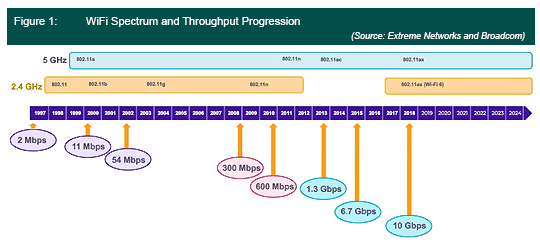FCC and Ofcom an Example for the Rest of the World
|
NEWS
|
The Federal Communications Commission (FCC) has recently made 1200 Megahertz (MHz) of spectrum in 6 GHz available for unlicensed usage. Prior to this, Wi-Fi 6 had two available bandwidths in the United States: 60 MHz in 2.4 GHz and 500 MHz in 5 GHz. The opening of 6 GHz for Wi-Fi 6 in the United States paves the way for the new Wi-Fi 6E routers, which are manufactured to support the 6 GHz spectrum. To clarify, Wi-Fi 6 routers can only support the 2.4 GHz or 5 GHz bands, and Wi-Fi 6E demarks when Wi-Fi 6 is using the 6 GHz band.
The Office of Communications (Ofcom), the United Kingdom’s communications regulator, has also proposed the lower 6 GHz band (5925 MHz to 6425 MHz) be made available for Wi-Fi. They have also proposed removing Dynamic Frequency Selection (DFS) requirements from Wi-Fi channels in the 5.8 GHz band (5725 MHZ to 5850 MHz). ABI Research believes that the United States and the United Kingdom’s recent moves are a pattern that the rest of the world’s regulators will follow.
Wi-Fi 6 is Brought to Greater Heights
|
IMPACT
|
This is a milestone in the 23 years of Wi-Fi history, where the last time spectrum (5 GHz) was allocated was about 20 years ago, even before the first smartphone was released. With the new 6 GHz spectrum, we will see more people adopt Wi-Fi due to the benefits the new spectrum will bring to the technology, as outlined in the following paragraph. According to ABI Research, Wi-Fi 6 technology will also contribute to Wi-Fi Industrial Device Shipments, which are forecast to increase from 5.7 million units in 2020 to 21.13 million units in 2025, with a Compound Annual Growth Rate (CAGR) of 29.9%, according to ABI Research’s Industrial Bluetooth and Wi-Fi Market Tracker (MD-IBWM-101).
The new 6 GHz spectrum will open a plethora of advantages for utilizing Wi-Fi for enterprise use cases, such as Augmented Reality (AR) and Virtual Reality (VR), high-density venues, and Industry 4.0 applications. The advantages include:
- Increase in Spectrum Availability: The new 6 GHz spectrum opens more than double the 2.4 GHz and 5 GHz spectrum available in the United States.
- Enhanced Throughput: The opening of non-overlapping channels in the 6 GHz spectrum—making it Gigabit capable and increasing data rates to 2+ Gigabytes Per Second (Gbps) due to increased utilization of wider 80 MHz and 160 MHz channels.
- Cleaner Channels: 6 GHz will also be free from legacy clients that hog airtime in the 2.4 GHz and 5 GHz bands, leading to better and more reliable performance. The removal of DFS will remove interference from radars and weather systems and the pauses in connectivity when switching channels.
Increasing Options for Wireless Industrial Deployments
|
RECOMMENDATIONS
|
Figure 1 shows the progression of Wi-Fi from its inception in 1997 until now. While Wi-Fi versions have traditionally been about speed progression, Wi-Fi 6 focuses more on high spectral efficiency through techniques such as Orthogonal Frequency-Division Multiple Access (OFDMA), a multi-user version of the Orthogonal Frequency Division Multiplexing (OFDM)—and better Quadrature Amplitude Modulation (QAM) modulation streams. Wi-Fi 6 also includes getting more spectrum, and thus increasing capacity, so that signals can go through at optimal speeds using unlicensed spectrum. Multi-User, Multiple Input, Multiple Output (MU-MIMO) for uplink will also be implemented for Wi-Fi 6, creating bidirectional MU-MIMO so that there are extra dedicated lanes for transferring information in both directions.
The introduction of Wi-Fi 6E through the 6 GHz spectrum will make Wi-Fi a more viable option for industrial wireless connectivity and outdoor venue connectivity in the United States. This is primarily due to the multifold performance gain due to the addition of 109 non-overlapping channels in the FCC’s 6 GHz spectrum release, the throughput capability of the new spectrum, and the freedom from older clients hogging airtime, overall improving reliability, throughput, quality of service and robustness.
AR/VR are some of the use cases that will benefit from the introduction of the new spectrum for Wi-Fi 6E. These are use cases that takes up a lot of bandwidth, with entire businesses built around tethering these devices. Wi-Fi 6E offers possibilities and wireless advantages for mobility that pose serious competition to fixed-line AR/VR business. Wi-Fi 6E can provide up to four times better wireless performance in high density areas by eliminating Co-Channel and Adjacent-Channel Interference (CCI and ACI) through the introduction of non-overlapping bandwidths. This will improve reliability and guarantee quality of service for high-performance low-latency applications such as industrial applications. Some of the industrial applications that can be enabled by Wi-Fi 6E in the 6 GHz band include remote control signaling (requiring <30ms latency and 99.999% reliability) and Automated Guided Vehicles (AGVs) (requiring <50ms latency and 99.9% reliability). Wi-Fi 6E will also have backward compatibility for current standard frequencies (using 2.4 GHz and 5GHz), allowing older devices to utilize the new technology. With the removal of DFS requirements, the cost for Wi-Fi 6 as a whole can also be expected to be lower.
